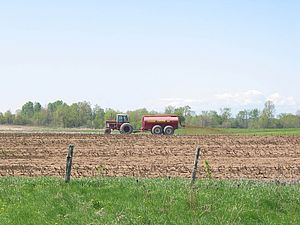Manure Happens

Manure spreading in the St. Albans watershed. Photo by Mike Winslow.
In the last few months courts in Washington State and Iowa have ruled that manure can be a pollutant. While many may see these decisions as obvious, manure has more frequently been considered a resource rather than a pollutant. In reality it can be both.
According to Statistics Canada, the average heifer produces 53 pounds of manure per day. Milk cows produce even more; up to 137 pounds per day. Smaller animals like sheep and pigs produce less manure, but still the quantities are impressive. Wherever animal agriculture exists, there is manure to be managed.
For farmers, all that manure contains nutrients and is therefore valuable as fertilizer. Properly managed, adding manure to croplands increases organic matter, water holding capacity, and overall soil health.
However excess nutrients from manure can pollute our waters. Crops use three times as much nitrogen as phosphorus, but they are about equally available in manure. Thus, adding enough manure to meet crops' nitrogen needs leads to an excess of phosphorus.
In the court cases referenced above, manure was declared a pollutant not because of its effect on surface waters, but for its effect on groundwater. In particular, nitrogen in manure can convert to nitrate, which is very mobile in groundwater. Excess nitrate can cause methemoglobinemia or blue-baby syndrome. The nitrogen undergoes transformation in babies' (typically undersix months) stomachs to a form that blocks oxygen from combining with hemoglobin in the blood, leading to slow suffocation. According to the USGS, aquifers in the northeast are not particularly vulnerable to nitrate groundwater pollution. The greatest area of vulnerability occurs in areas of the Midwest, particularly in Kansas and Nebraska.
Manure management comes down to two essential questions: how will the manure be stored, and how will it be applied to the land. Manure storage allows farmers to avoid spreading on frozen ground. Land application allows farmers' crops to take advantage of the nutrients.
Manure can be stored as a solid or as a liquid. When manure leaves a cow it is about 88 percent water. In order to be treated as solid manure, the water content needs to drop to 75 to 80 percent moisture. This can be achieved by adding dry bedding material, or allowing water to evaporate from the manure. Slurry systems handle manure with 90 to 96 percent water content. This product is still fairly viscous and specialized pumping equipment is necessary for handling. Highly diluted manure (greater than 96 percent water) can be pumped through irrigation systems. If manure is stored as a liquid it is easier to transport from the barn to the storage area. Additionally, milk house waste, which is the wash water from milking areas, can be mixed in with liquid manure.
Manure stored in a liquid form can lose much of its nitrogen. The high liquid content means a lack of oxygen. In the absence of oxygen, nitrogen can form ammonia, a compound which volatilizes to the atmosphere and gives liquid manure its pungent smell. Since nitrogen is in great demand by growing crops, its loss plays a big role in decisions about how much manure can be applied. Lack of nitrogen in manure can exacerbate problems with excess phosphorus.
Construction of manure storage facilities represents a substantial financial investment forfarmers. A guidance document from the University of Wisconsin Extension suggests cost run from $100 per cow for earthen ponds to $1,000 per cow for above ground storage tanks. Tools for spreading manure vary depending on how much liquid the manure has. Spreaders for solid or semi-solid manure are relatively cheap, but they do not allow even distribution of the manure. Some parts of a field may get more manure than others. Liquid manure can be spread from tanker trucks or drag hoses, both of which allow more uniform application. In any case, manure should be applied in conformance with a nutrient management plan and incorporated into the soil within a few days of spreading in order to preserve nutrients for the crops and avoid water pollution.
In recent years using manure for generation of electricity has become a more popular option. Manure digesters capture the methane, natural gas, released as manure decomposes, then burn it in an electric generator. The manure does not disappear in the process, but its volume is reduced, thus reducing the need for storage, and creating other options for how it is managed. Dried manure can be used for bedding or packaged as garden fertilizer. Green Mountain Power receives a portion of the energy it sells from such digesters.
Manure application is a very visible aspect of farming. As such it draws attention and ire when water quality is compromised. Manure application in excess of a proscribed nutrient management plan creates problems. When manure is applied just before heavy rain or onto frozen ground or isn't incorporated into the soil, it leads to nutrient run-off. Yet manure is also a valuable resource and its proper use can allow farmers to import less inorganic fertilizer from outside the watershed. If we're serious about cleaning up waterways we're going to need tighter controls on how manure is managed.
